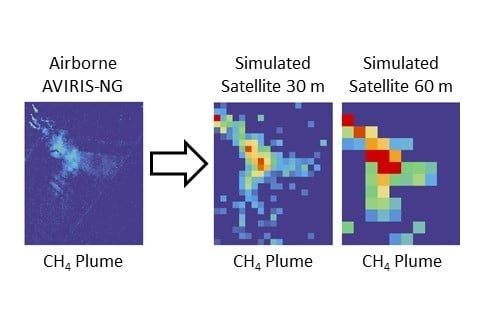Methane Mapping with Future Satellite Imaging Spectrometers
Abstract
1. Introduction
2. Methods
2.1. Imagery
2.2. Simulated Satellite Images
2.2.1. Aircraft to Top-of-Atmosphere
2.2.2. Spectral Resampling
2.2.3. Resample Spatial Resolution
2.2.4. Sensor Noise
2.3. Matched Filter Methane Retrieval
2.4. Integrated Mass Enhancement
2.5. Flux Estimate
3. Results and Discussion
3.1. Methane Plumes by Sector
3.1.1. Petroleum and Natural Gas
3.1.2. Landfill/Wastewater Treatment
3.1.3. Dairies
3.1.4. Controlled Release
3.2. Flux
3.3. Spatial Resolution and Signal-to Noise Ratio
3.4. Limitations
4. Conclusions
Author Contributions
Funding
Acknowledgments
Conflicts of Interest
Appendix A
| Attribute | Values |
|---|---|
| Wavelengths | 350–2500 nm |
| Carbon dioxide | 405 ppm |
| Water Vapor | 1245.3 atm-cm |
| Visibility | 30 km |
| Methane | 1.7 ppm |
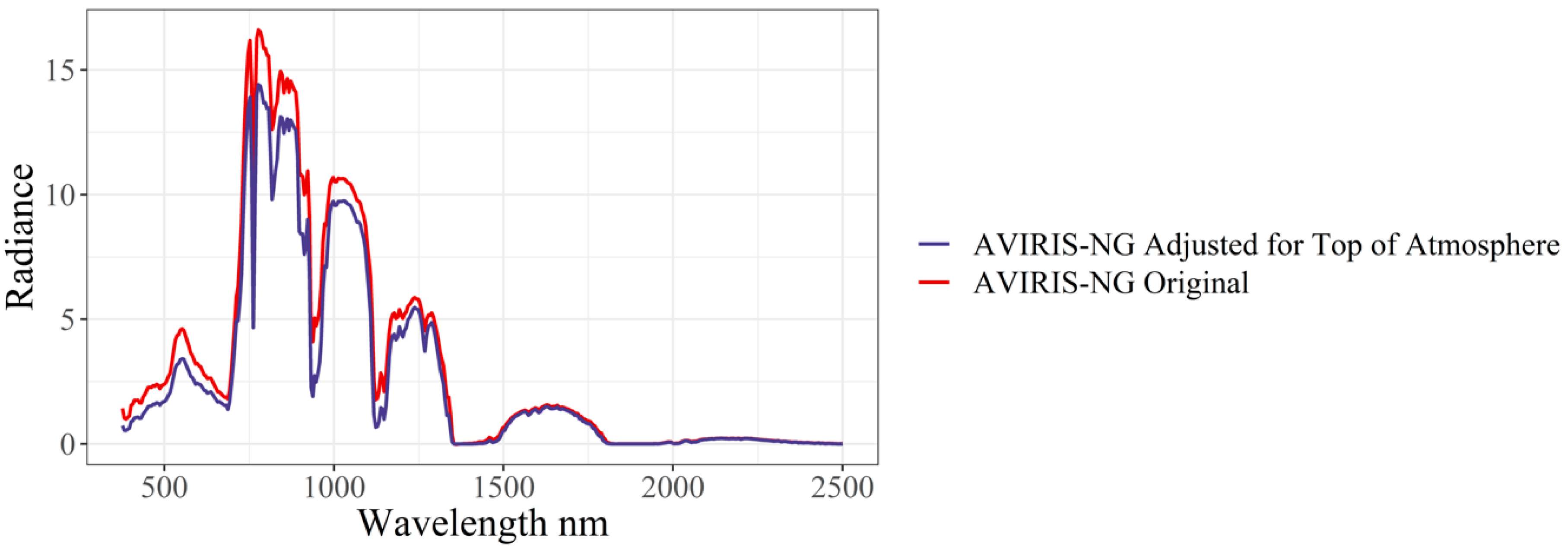
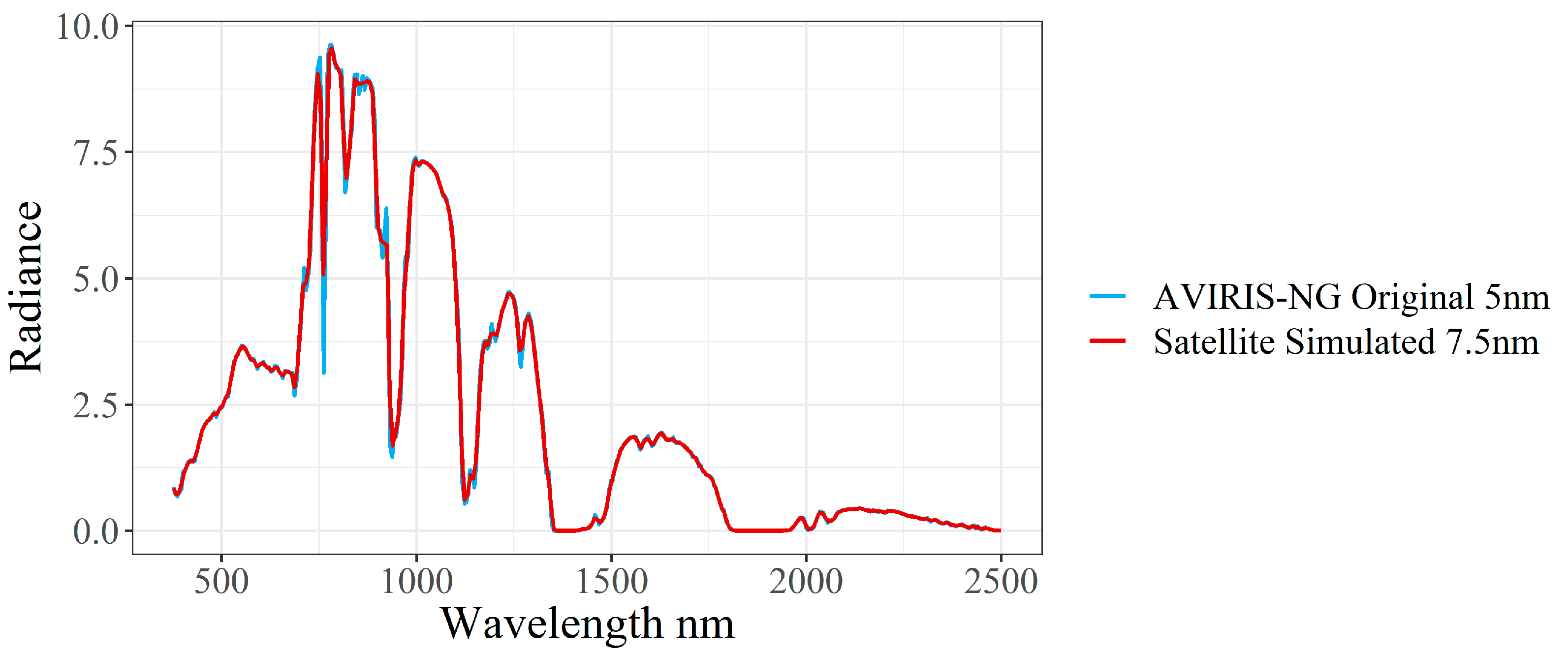
| Source | IME (kg) | Length (m) | ||||
|---|---|---|---|---|---|---|
| AVIRIS-NG | 30 m | 60 m | AVIRIS-NG | 30 m | 60 m | |
| Gas Storage Facility | 70.23 | 116.51 | 128.23 | 671.50 | 900.00 | 885.89 |
| Well *** | 13.30 | 28.60 | 14.63 | 314.87 | 550.73 | 349.86 |
| Gas Distribution Line | 6.99 | 11.54 | 14.51 | 224.79 | 258.07 | 323.11 |
| Landfill * | 325.73 | 442.21 | 469.16 | 2123.18 | 2200.66 | 2264.16 |
| Wastewater Treatment † | 5.54 | 2.02 | 3.22 | 208.97 | 94.87 | 134.16 |
| Dairy Manure Lagoon ** | 12.51 | 9.78 | 10.05 | 360.80 | 192.09 | 240.00 |
| Dairy Digester | 23.96 | 28.60 | 24.40 | 483.04 | 550.73 | 468.62 |
| Controlled Release | 1.62 | 1.59 | 0.58 | 97.71 | 67.08 | 62.92 |
| Source | Mean Wind Speed (m/s) | Standard Deviation Wind Speed (m/s) |
|---|---|---|
| Gas Storage Facility | 1.395 | 0.430 |
| Pump Jack | 3.213 | 0.348 |
| Pipeline Leak | 3.187 | 3.479 |
| Landfill | 3.094 | 0.267 |
| Wastewater Treatment | 2.075 | 0.423 |
| Dairy Manure Lagoon | 2.230 | 0.602 |
| Dairy Digester | 3.637 | 0.610 |
| Controlled Release | 1.959 | 0.258 |
References
- Ciais, P.; Sabine, C.; Bala, G.; Bopp, L.; Brovkin, V.; Canadell, J.; Chhabra, A.; DeFries, R.; Galloway, J.; Heimann, M.; et al. “Carbon and Other Biogeochemical Cycles.”. In Climate Change 2013 – The Physical Science Basis: Working Group I Contribution to the Fifth Assessment Report of the Intergovernmental Panel on Climate Change; Cambridge University Press: Cambridge, UK, 2014; pp. 465–570. [Google Scholar] [CrossRef]
- Saunois, M.; Bousquet, P.; Poulter, B.; Peregon, A.; Ciais, P.; Canadell, J.G.; Janssens-Maenhout, G.; Giuseppe, E.; David, B.; Houweling, S.; et al. The global methane budget 2000–2012. Earth Syst. Sci. Data 2016, 8, 697–751. [Google Scholar] [CrossRef]
- Kirschke, S.; Bousquet, P.; Ciais, P.; Saunois, M.; Canadell, J.G.; Dlugokencky, E.J.; Bergamaschi, P.; Bergmann, D.; Blake, D.R.; Bruhwiler, L.; et al. Three decades of global methane sources and sinks. Nat. Geosci. 2013, 6, 813–823. [Google Scholar] [CrossRef]
- Inventory of US Greenhouse Gas Emissions and Sinks: 1990–2014; U.S. Environmental Protection Agency: Washington, DC, USA, 2016.
- Allen, D.T.; Pacsi, A.P.; Sullivan, D.W.; Zavala-araiza, D.; Harrison, M.; Keen, K.; Fraser, M.P.; Hill, A.D.; Sawyer, R.F.; Seinfeld, J.H. Methane Emissions from Process Equipment at Natural Gas Production Sites in the United States: Pneumatic Controllers. Environ. Sci. Technol. 2015, 49, 641–648. [Google Scholar] [CrossRef] [PubMed]
- Frankenberg, C.; Thorpe, A.K.; Thompson, D.R.; Hulley, G.; Kort, E.A.; Vance, N.; Borchardt, J.; Krings, T.; Gerilowski, K.; Sweeney, C.; et al. Airborne methane remote measurements reveal heavy-tail flux distribution in Four Corners region. Proc. Natl. Acad. Sci. USA 2016, 113, 9734–9739. [Google Scholar] [CrossRef] [PubMed]
- Duren, R.M.; Thorpe, A.K.; Foster, K.T.; Rafiq, T.; Hopkins, F.M.; Yadav, V.; Bue, B.D.; Thompson, D.R.; Conley, S.; Colombi, N.; et al. California’s Methane Super-Emitters. Nature 2019, 575, 180–184. [Google Scholar] [CrossRef]
- Hu, H.; Aben, I.; Landgraf, J.; Detmers, R.; Borsdorff, T.; Butz, A. Toward Global Mapping of Methane With TROPOMI: First Results and Intersatellite Comparison to GOSAT. Geophys. Res. Lett. 2018, 45, 3682–3689. [Google Scholar] [CrossRef]
- Xiong, X.; Barnet, C.; Maddy, E.; Sweeney, C.; Liu, X.; Zhou, L.; Goldberg, M. Characterization and validation of methane products from the Atmospheric Infrared Sounder (AIRS). J. Geophys. Res. Biogeosci. 2008, 113, 1–14. [Google Scholar] [CrossRef]
- Frankenberg, C.; Meirink, J.F.; van Weele, M.; Platt, U.; Wagner, T. Assessing Methane Emissions from Global Space-Borne Observations. Science 2005, 308, 1010–1014. [Google Scholar] [CrossRef]
- Turner, A.J.; Frankenberg, C.; Wennberg, P.O.; Jacob, D.J. Ambiguity in the causes for decadal trends in atmospheric methane and hydroxyl. Proc. Natl. Acad. Sci. 2017, 114, 5367–5372. [Google Scholar] [CrossRef]
- Cusworth, D.H.; Jacob, D.J.; Sheng, J.; Benmergui, J.; Turner, A.J.; Brandman, J.; White, L.; Randles, C.A. Detecting high-emitting methane sources in oil/gas fields using satellite observations. Atmos. Chem. Phys. 2018, 16885–16896. [Google Scholar] [CrossRef]
- Varon, D.J.; Jacob, D.J.; Mckeever, J.; Jervis, D.; Durak, B.O.A.; Xia, Y. Quantifying methane point sources from fine-scale ( GHGSat ) satellite observations of atmospheric methane plumes. Atmos. Meas. Tech. 2018, 11, 5673–5686. [Google Scholar] [CrossRef]
- Varon, D.J.; Mckeever, J.; Jervis, D.; Maasakkers, J.D.; Pandey, S.; Houweling, S. Satellite discovery of anomalously large methane point sources from oil/gas production. Geophys. Res. Lett. 2019. [Google Scholar] [CrossRef]
- Rast, M.; Painter, T.H. Earth Observation Imaging Spectroscopy for Terrestrial Systems: An Overview of Its History, Techniques, and Applications of Its Missions. Surv. Geophys. 2019, 40, 303–331. [Google Scholar] [CrossRef]
- Roberts, D.A.; Bradley, E.S.; Cheung, R.; Leifer, I.; Dennison, P.E.; Margolis, J.S. Mapping methane emissions from a marine geological seep source using imaging spectrometry. Remote Sens. Environ. 2010, 114, 592–606. [Google Scholar] [CrossRef]
- Thorpe, A.K.; Roberts, D.A.; Bradley, E.S.; Funk, C.C.; Dennison, P.E.; Leifer, I. High resolution mapping of methane emissions from marine and terrestrial sources using a Cluster-Tuned Matched Filter technique and imaging spectrometry. Remote Sens. Environ. 2013, 134, 305–318. [Google Scholar] [CrossRef]
- Thorpe, A.K.; Frankenberg, C.; Thompson, D.R.; Duren, R.M.; Aubrey, A.D.; Bue, B.; Green, R.O.; Gerilowski, K.; Krings, T.; Borchard, J.; et al. Airborne retrievals of methane, carbon dioxide, and water vapor concentrations at high spatial resolution: application to AVIRIS-NG. Atmos. Meas. Tech. 2017, 10, 3833–3850. [Google Scholar] [CrossRef]
- Thompson, D.R.; Leifer, I.; Bovensmann, H.; Eastwood, M.; Fladeland, M.; Frankenberg, C.; Gerilowski, K. Real-time remote detection and measurement for airborne imaging spectroscopy: a case study with methane. Atmos. Meas. Tech. 2015, 8, 4383–4397. [Google Scholar] [CrossRef]
- Bradley, E.S.; Leifer, I.; Roberts, D.A.; Dennison, P.E.; Washburn, L. Detection of marine methane emissions with AVIRIS band ratios. Geophys. Res. Lett. 2011, 38. [Google Scholar] [CrossRef]
- Gao, B.-C.; Goetz, A.F.H. Column atmospheric water vapor and vegetation liquid water retrievals from Airborne Imaging Spectrometer data. J. Geophys. Res. 1990, 95, 3549. [Google Scholar] [CrossRef]
- Thorpe, A.K.; Roberts, D.A.; Dennison, P.E.; Bradley, E.S.; Funk, C.C. Point source emissions mapping using the Airborne Visible/Infrared Imaging Spectrometer (AVIRIS). In Proceedings of the SPIE Proceedings-Algorithms Technol. Multispectral, Hyperspectral, Ultraspectral Imag. XVIII, Baltimore, MD, USA, 15 May 2012. [Google Scholar] [CrossRef]
- Stefano, P.; Angelo, P.; Simone, P.; Filomena, R.; Federico, S.; Umberto, A.; Vincenzo, C.; Roberto, D.B.; Giovanni, L.; La, R.; et al. The PRISMA hyperspectral mission: science activities and opportunities for agriculture and land monitoring. In Proceedings of the 2013 IEEE International Geoscience and Remote Sensing Symposium(IGARSS), Melbourne, VIC, Australia, 21–26 July 2013; pp. 4558–4561. [Google Scholar]
- Loizzo, R.; Guarini, R.; Longo, F.; Scopa, T.; Formaro, R.; Facchinetti, C.; Varacalli, G. PRISMA: THE Italian hyperspectral mission. In Proceedings of the 2018 IEEE International Geoscience and Remote Sensing Symposium, Valencia, Spain, 22–27 July 2018; pp. 175–178. [Google Scholar]
- Guanter, L.; Kaufmann, H.; Segl, K.; Foerster, S.; Rogass, C.; Chbrillat, S.; Fischer, S.; Schrader, S.; Storch, T.; Heiden, U.; et al. The EnMAP Spaceborne Imaging Spectroscopy Mission for Earth Observation. Remote Sens. 2015, 7, 8830–8857. [Google Scholar] [CrossRef]
- Matsunaga, T.; Iwasaki, A.; Tsuchida, S.; Iwao, K.; Tanii, J.; Kashimura, O.; Nakamurac, R.; Yamamotoc, H.; Katoc, S.; Obatac, K.; et al. Hisui Status Toward Fy2019 Launch. IEEE Int. Geosci. Remote Sens. Symp. 2018, 160–163. [Google Scholar]
- Thriving on Our Changing Planet: A Decadal Strategy for Earth Observation from Space; National Academies of Sciences Engineering and Medicine: Washington, DC, USA, 2018; ISBN 9780309467575.
- Thompson, D.R.; Thorpe, A.K.; Frankenberg, C.; Green, R.O.; Duren, R.; Guanter, L.; Hollstein, A.; Middleton, E.; Ong, L.; Ungar, S. Space-based Remote Imaging Spectroscopy of the Aliso Canyon CH4 Super-emitter. Geophys. Res. Lett. 2016, 43, 6571–6578. [Google Scholar] [CrossRef]
- Green, R.O.; Mahowald, N.M.; Clark, R.N.; Ehlmann, B.L.; Ginoux, P.A.; Kalashnikova, O.V.; Miller, R.L.; Okin, G.; Painter, T.H.; Pérez García-Pando, C.; et al. NASA’s Earth Surface Mineral Dust Source Investigation. Proceedings of AGU Fall Meeting 2018, Washington, DC, USA, 10–14 December 2018. [Google Scholar]
- Hamlin, L.; Green, R.O.; Mouroulis, P.; Eastwood, M.; Wilson, D.; Dudik, M.; Paine, C. Imaging spectrometer science measurements for terrestrial ecology: AVIRIS and new developments. In Proceedings of the 2011 Aerospace Conference, Big Sky, MT, USA, 5–12 March 2011; 2011; pp. 1–7. [Google Scholar]
- Green, R.O.; Eastwood, M.L.; Sarture, C.M.; Chrien, T.G.; Aronsson, M.; Chippendale, B.J.; Faust, J.A.; Pavri, B.E.; Chovit, C.J.; Solis, M.; et al. Imaging spectroscopy and the Airborne Visible/Infrared Imaging Spectrometer (AVIRIS). Remote Sens. Environ. 1998, 65, 227–248. [Google Scholar] [CrossRef]
- Chapman, J.W.; Thompson, D.R.; Helmlinger, M.C.; Bue, B.D.; Green, R.O.; Eastwood, M.L.; Geier, S.; Olson-duvall, W.; Lundeen, S.R. Spectral and Radiometric Calibration of the Next Generation Airborne Visible Infrared Spectrometer (AVIRIS-NG). Remote Sens. 2019, 11, 2129. [Google Scholar] [CrossRef]
- Duren, R.; Thorpe, A.; Sander, S. California Baseline Methane Survey-Interim Phase 1 report. In Proceedings of the 2017 AGU Fall Meeting, New Orleans, LA, USA, 11–15 December 2017. [Google Scholar]
- Berk, A.; Conforti, P.; Kennett, R.; Perkins, T.; Hawes, F.; Van Den Bosch, J. MODTRAN® 6: A major upgrade of the MODTRAN® radiative transfer code. In Proceedings of the 2014 6th Workshop on Hyperspectral Image and Signal Processing: Evolution in Remote Sensing (WHISPERS), Lausanne, Switzerland, 24–27 June 2014. [Google Scholar]
- Funk, C.C.; Theiler, J.; Roberts, D.A.; Borel, C.C. Clustering to improve matched filter detection of weak gas plumes in hyperspectral thermal imagery. IEEE Trans. Geosci. Remote Sens. 2001, 39, 1410–1420. [Google Scholar] [CrossRef]
- Theiler, J.; Foy, B.R. Effect of signal contamination in matched-filter detection of the signal on a cluttered background. IEEE Geosci. Remote Sens. Lett. 2006, 3, 98–102. [Google Scholar] [CrossRef]
- Manolakis, D.; Lockwood, R.; Cooley, T.; Jacobson, J. Robust Matched Filters for Target Detection in Hyperspectral Imaging Data. In Proceedings of the 2007 IEEE International Conference on Acoustics, Speech and Signal Processing - ICASSP ’07, Honolulu, HI, USA, 15–20 April 2007. [Google Scholar]
- Donoho, D.L. Compressed sensing. IEEE Trans. Inf. Theory 2006, 52, 1289–1306. [Google Scholar] [CrossRef]
- Candès, E. Compressive sampling. In Proceedings of the International Congress of Mathematicians, Madrid, Spain, 22–30 August 2006; pp. 1433–1452. [Google Scholar]
- Lustig, M.; Donoho, D.; Pauly, J.M. Sparse MRI: The application of compressed sensing for rapid MR imaging. Magn. Reson. Med. 2007, 58, 1182–1195. [Google Scholar] [CrossRef]
- Wiaux, Y.; Jacques, L.; Puy, G.; Scaife, A.M.M.; Vandergheynst, P. Compressed sensing imaging techniques for radio interferometry. Mon. Not. R. Astron. Soc. 2009, 395, 1733–1742. [Google Scholar] [CrossRef]
- Stevens, A.; Kovarik, L.; Abellan, P.; Yuan, X.; Carin, L.; Browning, N.D. Applying compressive sensing to TEM video: a substantial frame rate increase on any camera. Adv. Struct. Chem. Imaging 2015, 1, 10. [Google Scholar] [CrossRef]
- Beck, A.; Teboulle, M. A Fast Iterative Shrinkage-Thresholding Algorithm for Linear Inverse Problems. SIAM J. Imaging Sci. 2009, 2, 183–202. [Google Scholar] [CrossRef]
- Theiler, J.; Foy, B.R.; Fraser, A.M. Nonlinear signal contamination effects for gaseous plume detection in hyperspectral imagery. In Proceedings of the Defense and Security Symposium, Orlando, FL, USA, 17–21 April 2006. [Google Scholar]
- Foote, M.; Dennison, P.; Thorpe, A.; Thompson, D.; Jongaramrungruang, S.; Frankenberg, C.; Joshi, S. Fast and Accurate Retrieval of Methane Concentration from Imaging Spectrometer Data Usinf Sparsity Prior. IEEE TGRS. in press.
- Blaylock, B.K.; Horel, J.D.; Liston, S.T. Computers and Geosciences Cloud archiving and data mining of High-Resolution Rapid Refresh forecast model output. Comput. Geosci. 2017, 109, 43–50. [Google Scholar] [CrossRef]
- Horel, J.; Blaylock, B. Archive of the High Resolution Rapid Refresh model. Available online: https://hive.utah.edu/concern/datasets/47429912h (accessed on 6 January 2019).
- EPA. Global Mitigation of Non-CO 2 Greenhouse Gases: 2010–2030. 2013. Available online: https://www.epa.gov/sites/production/files/2016-06/documents/mac_report_2013.pdf (accessed on 1 February 2017).
- Kort, E.A.; Frankenberg, C.; Costigan, K.R.; Lindenmaier, R.; Dubey, M.K.; Wunch, D. Four corners: The largest US methane anomaly viewed from space. Geophys. Res. Lett. 2014, 41, 6898–6903. [Google Scholar] [CrossRef]
- Cusworth, D.H.; Jacob, D.J.; Varon, D.J.; Miller, C.C.; Liu, X.; Chance, K. Potential of next-generation imaging spectrometers to detect and quantify methane point sources from space. Atmos. Meas. Tech. 2019, 12, 5655–5668. [Google Scholar] [CrossRef]
- Bingemer, H.G.; Crutzen, P.J. The production of methane from solid wastes. J. Geophys. Res. 1987, 92, 2181. [Google Scholar] [CrossRef]
- Themelis, N.J.; Ulloa, P.A. Methane generation in landfills. Renew. Energy 2007, 32, 1243–1257. [Google Scholar] [CrossRef]
- Goldsmith, C.D.; Chanton, J.; Abichou, T.; Swan, N.; Green, R.; Hater, G. Methane emissions from 20 landfills across the United States using vertical radial plume mapping. J. Air Waste Manage. Assoc. 2012, 62, 183–197. [Google Scholar] [CrossRef]
- Jiang, Y.; Banks, C.; Zhang, Y.; Heaven, S.; Longhurst, P. Quantifying the percentage of methane formation via acetoclastic and syntrophic acetate oxidation pathways in anaerobic digesters. Waste Manag. 2018, 71, 749–756. [Google Scholar] [CrossRef] [PubMed]
- Westerholm, M.; Moestedt, J.; Schnürer, A. Biogas production through syntrophic acetate oxidation and deliberate operating strategies for improved digester performance. Appl. Energy 2016, 179, 124–135. [Google Scholar] [CrossRef]
- Townsend-Small, A.; Tyler, S.C.; Pataki, D.E.; Xu, X.; Christensen, L.E. Isotopic measurements of atmospheric methane in Los Angeles, California, USA: Influence of “fugitive” fossil fuel emissions. J. Geophys. Res. Atmos. 2012, 117, 1–11. [Google Scholar] [CrossRef]
- Ayasse, A.K.; Thorpe, A.K.; Roberts, D.A.; Frankenberg, C.; Aubrey, A.D.; Dennison, P.E.; Funk, C.C.; Teffke, A. Evaluating the effects of surface properties on methane retrievals using a synthetic airborne visible/infrared imaging spectrometer next generation (AVIRIS-NG) image. Remote Sens. Environ. 2018, 215, 386–397. [Google Scholar] [CrossRef]
- Thorpe, A.K.; Frankenberg, C.; Green, R.O.; David, R.; Aubrey, A.D.; Mouroulis, P.; Eastwood, M.L. The Airborne Methane Plume Spectrometer ( AMPS ): Quantitative Imaging of Methane Plumes in Real Time. In Proceedings of the IEEE Aerospace Conference, Big Sky, MT, USA, 5–12 March 2016. [Google Scholar]

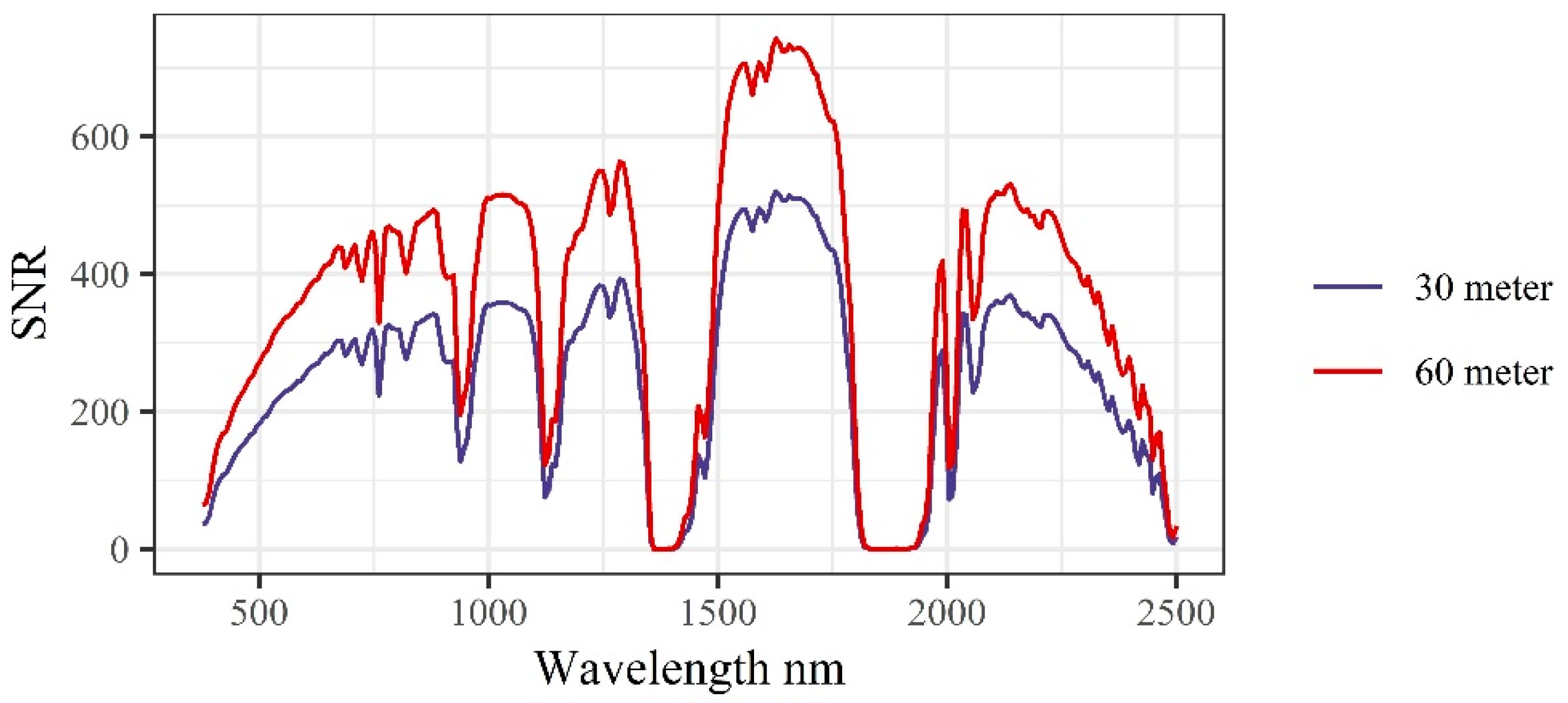
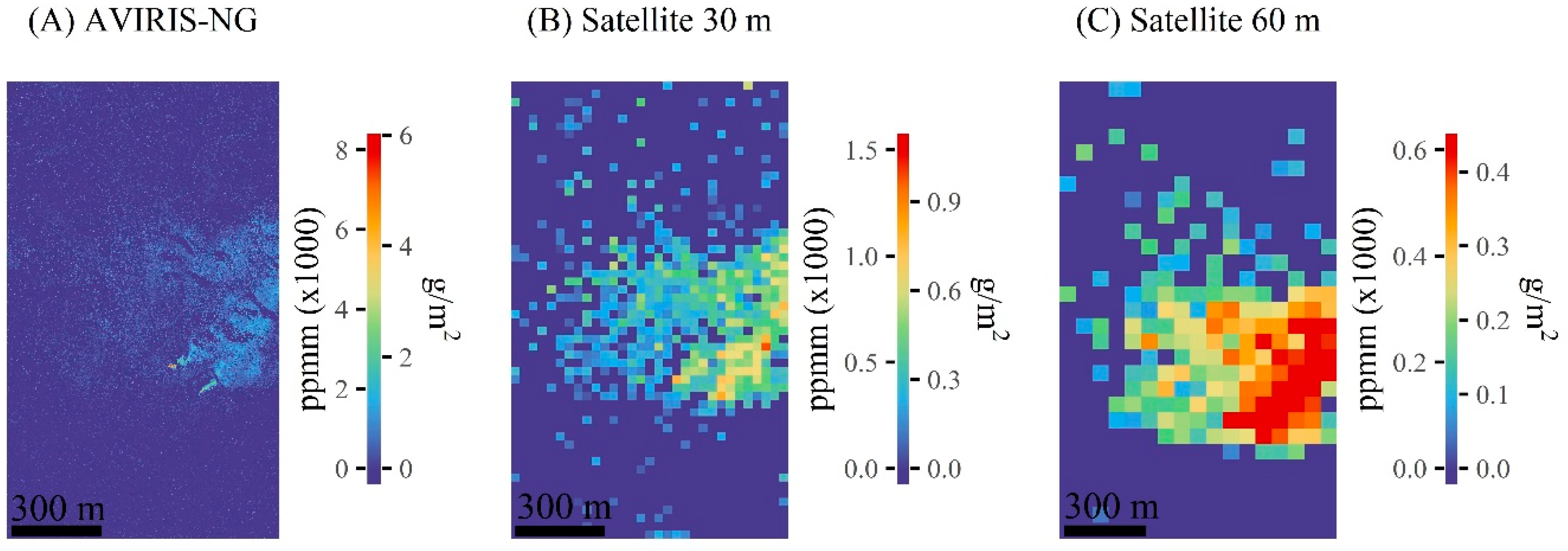



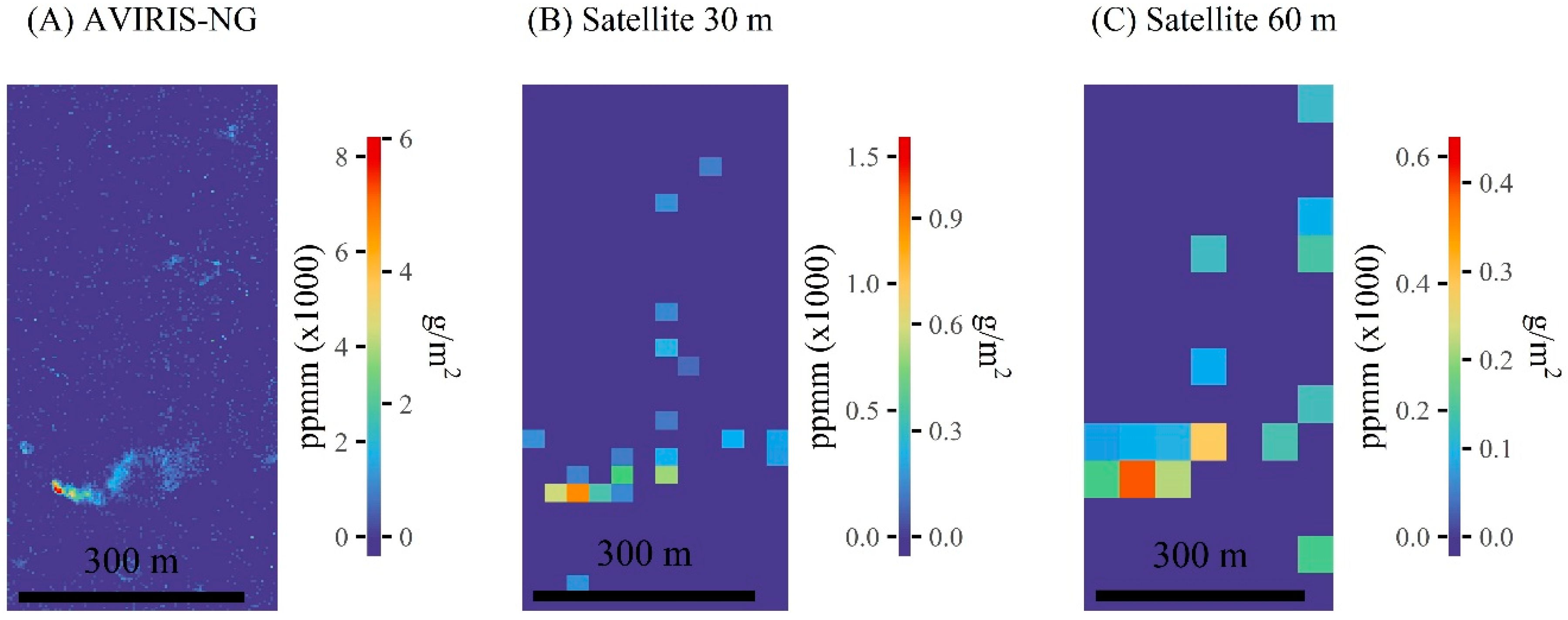



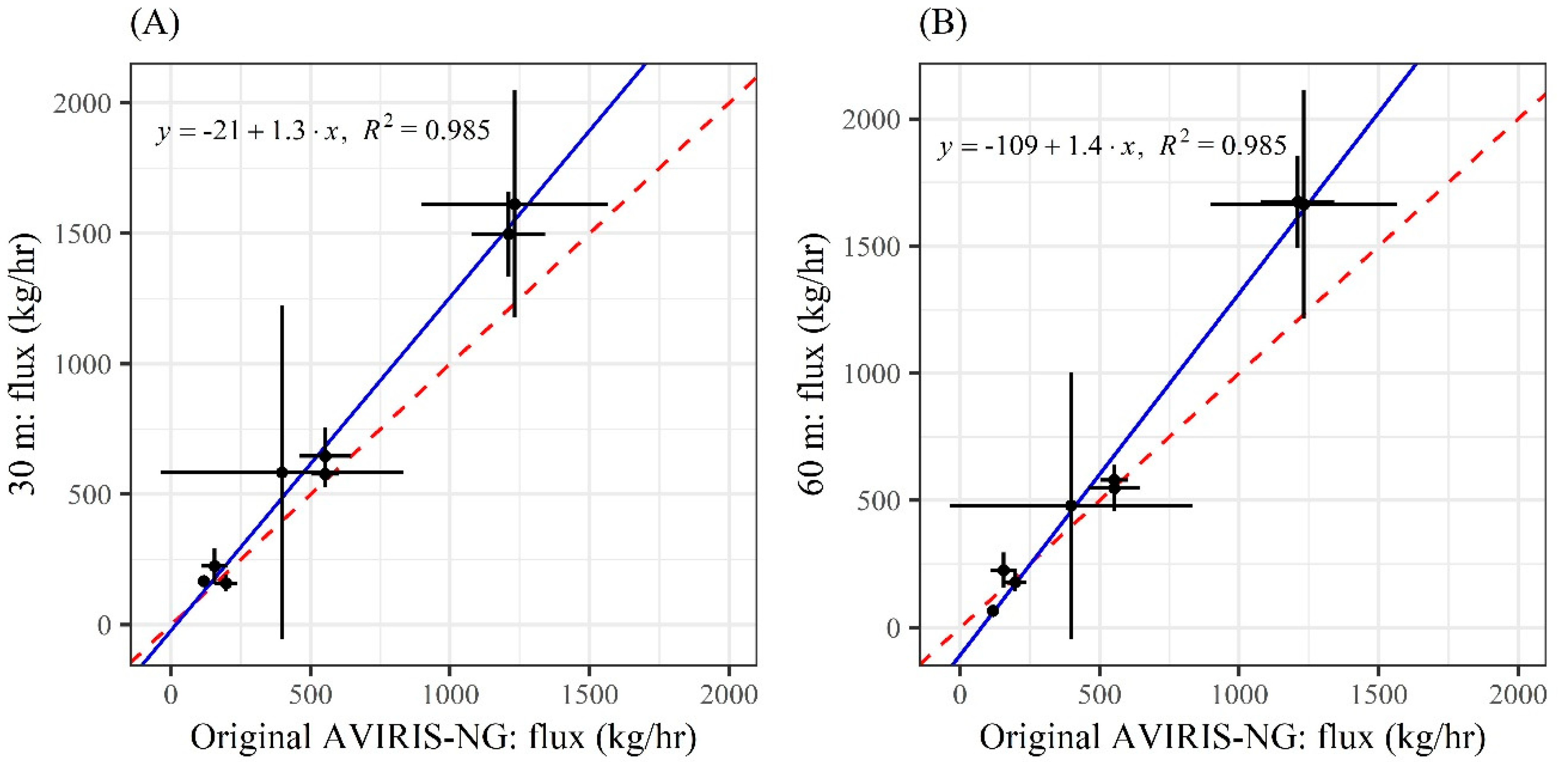
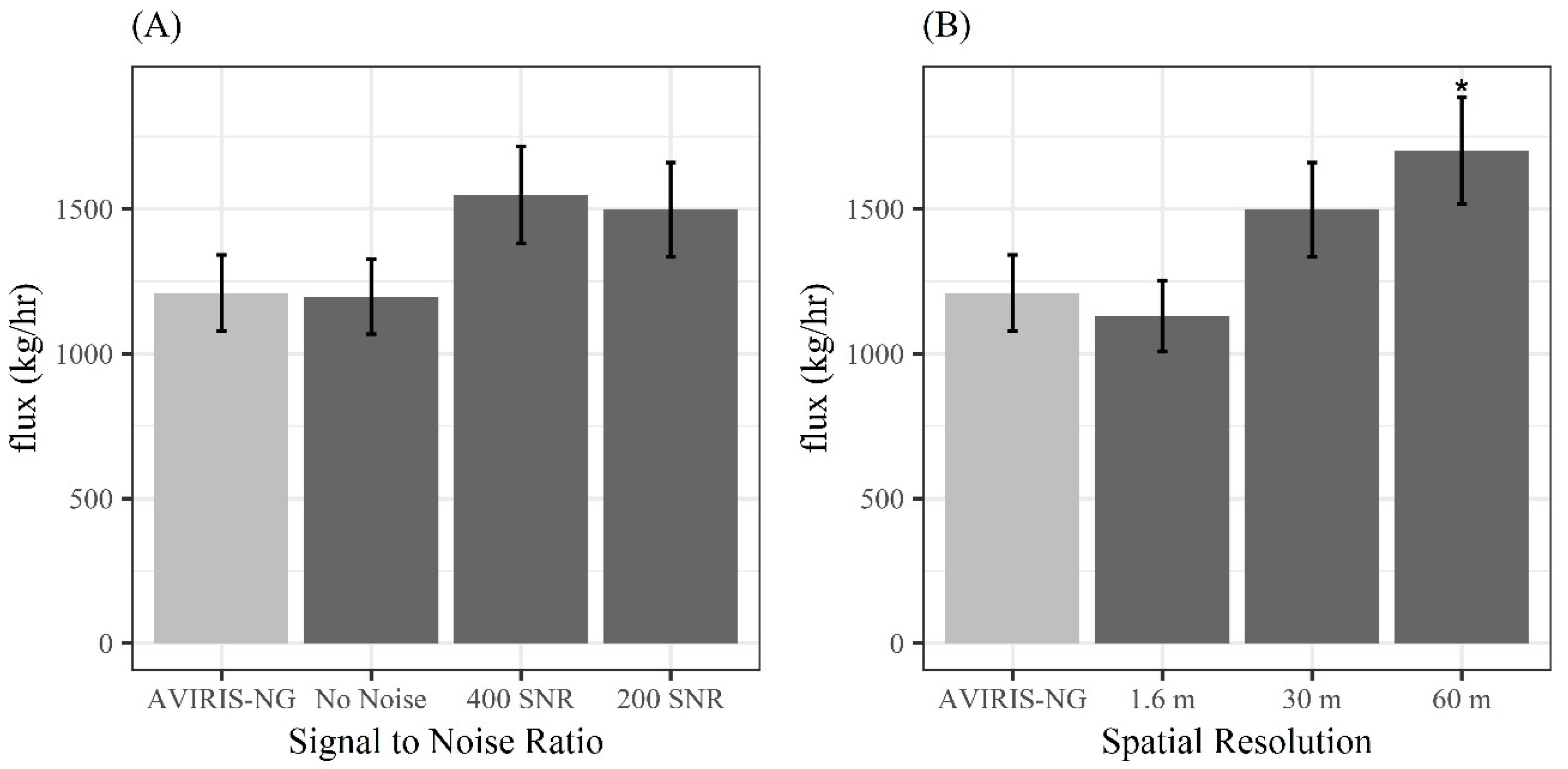
| Line Name | Source Type | Date of Flight | Time of Flight (UTC) | Spatial Resolution |
|---|---|---|---|---|
| ang20161104t183025 | Gas Storage Facility | 11/4/2016 | 18:30:25 | 1.6 m |
| ang20160915t185210 | Gas Distribution Line | 9/15/2016 | 18:52:10 | 1.7 m |
| ang20170618t194516 | Landfill | 6/18/2017 | 19:45:16 | 3.3 m |
| ang20170918t201542 | Well | 9/18/2017 | 20:15:42 | 3.3 m |
| ang20170618t193955 | Wastewater Treatment | 6/18/2017 | 19:39:55 | 3.3 m |
| ang20170616t210522 | Dairy Manure Lagoon | 6/16/2017 | 21:05:22 | 3.0 m |
| ang20170616t212046 | Dairy Digester | 6/16/2017 | 21:20:46 | 3.0 m |
| ang20180917t201723 | Controlled Release | 9/17/2018 | 20:17:23 | 2.3 m |
| Source | Flux (kg/h) | ||
|---|---|---|---|
| AVIRIS-NG | 30 m | 60 m | |
| Gas Storage Facility | 1209.97 ± 131.11 | 1497.54 ± 162.26 | 1674.46 ± 181.43 |
| Well | 553.03 ± 92.76 | 578.53 ± 108.46 | 547.73 ± 91.87 |
| Gas Distribution Line | 156.20 ± 48.17 | 224.63 ± 69.28 | 225.62 ± 69.58 |
| Landfill | 1231.67 ± 332.78 | 1613.23 ± 435.87 | 1663.51 ± 449.45 |
| Wastewater Treatment | 198.00 ± 40.38 | 159.42 ± 32.51 | 179.11 ± 36.53 |
| Dairy Manure Lagoon | 397.89 ± 434.38 | 584.28 ± 637.86 | 480.28 ± 524.33 |
| Dairy Digester | 552.65 ± 47.75 | 578.53 ± 49.98 | 580.00 ± 20.11 |
| Controlled Release | 117.59 ± 15.53 | 167.20 ± 22.09 | 65.42 ± 8.64 |
© 2019 by the authors. Licensee MDPI, Basel, Switzerland. This article is an open access article distributed under the terms and conditions of the Creative Commons Attribution (CC BY) license (http://creativecommons.org/licenses/by/4.0/).
Share and Cite
Ayasse, A.K.; Dennison, P.E.; Foote, M.; Thorpe, A.K.; Joshi, S.; Green, R.O.; Duren, R.M.; Thompson, D.R.; Roberts, D.A. Methane Mapping with Future Satellite Imaging Spectrometers. Remote Sens. 2019, 11, 3054. https://doi.org/10.3390/rs11243054
Ayasse AK, Dennison PE, Foote M, Thorpe AK, Joshi S, Green RO, Duren RM, Thompson DR, Roberts DA. Methane Mapping with Future Satellite Imaging Spectrometers. Remote Sensing. 2019; 11(24):3054. https://doi.org/10.3390/rs11243054
Chicago/Turabian StyleAyasse, Alana K., Philip E. Dennison, Markus Foote, Andrew K. Thorpe, Sarang Joshi, Robert O. Green, Riley M. Duren, David R. Thompson, and Dar A. Roberts. 2019. "Methane Mapping with Future Satellite Imaging Spectrometers" Remote Sensing 11, no. 24: 3054. https://doi.org/10.3390/rs11243054
APA StyleAyasse, A. K., Dennison, P. E., Foote, M., Thorpe, A. K., Joshi, S., Green, R. O., Duren, R. M., Thompson, D. R., & Roberts, D. A. (2019). Methane Mapping with Future Satellite Imaging Spectrometers. Remote Sensing, 11(24), 3054. https://doi.org/10.3390/rs11243054






